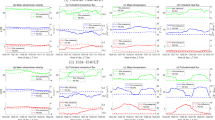Abstract
We propose a new approach to derive spatially-averaged momentum equations for an urban canopy model that resolves buildings vertically and not horizontally. First, in order to mathematically describe the actual momentum field as a completely continuous field, the underling concepts of the immersed boundary method are employed, where we assume that (i) the entire simulation space, including that occupied by buildings, is filled with a fluid, and (ii) an external body force field exists that reduces the wind speed to zero at all positions coinciding with the space occupied by the buildings. Then, in order to obtain the required spatially-averaged momentum equations in a self-consistent manner, a spatial-averaging operation is applied to the Navier–Stokes equations that include a term representing the external force field. The applied spatial-averaging operation is equivalent to the conventional spatial filtering operation used in large-eddy simulations. To examine the significance of the subgrid-scale (SGS) stresses of the spatially-averaged momentum equations, a numerical simulation is performed for a flow around a regular array of cubical blocks with a grid resolution that is sufficient to resolve the blocks. By estimating the individual terms in the spatially-averaged momentum equations using the simulation results, we show that the SGS stresses contribute significantly to the spatially-averaged momentum budget, and therefore they should not be neglected in urban canopy modelling.
Similar content being viewed by others
References
Amsden AA, Harlow FH (1970) A simplified MAC technique for incompressible fluid flow calculations. J Comput Phys 6: 322–325
Castro IP, Cheng H, Reynolds R (2006) Turbulence over urban-type roughness: deduction from wind tunnel measurements. Boundary-Layer Meteorol 118: 109–131
Cheng H, Castro IP (2002) Near wall flow over urban-like roughness. Boundary-Layer Meteorol 104: 229–259
Coceal O, Belcher SE (2004) A canopy model of mean winds through urban areas. Q J Roy Meteorol Soc 130: 1349–1372
Coceal O, Thomas TG, Castro IP, Belcher SE (2006) Mean flow and turbulence statistics over groups of urban-like cubical obstacles. Boundary-Layer Meteorol 121: 491–519
Coceal O, Dobre A, Thomas TG, Belcher SE (2007) Structure of turbulent flow over regular arrays of cubical roughness. J Fluid Mech 589: 375–409
Fadlun EA, Verzicco R, Orlandi P, Mohd-Yusof J (2000) Combined immersed-boundary finite-difference methods for three-dimensional complex flow simulations. J Comput Phys 161: 35–60
Fureby C, Tabor G (1997) Mathematical and physical constraints on large-eddy simulations. Theor Comput Fluid Dyn 9: 85–102
Finnigan J (2000) Turbulence in plant canopies. Annu Rev Fluid Mech 32: 519–571
Germano M, Piomelli U, Moin P, Cabot WH (1991) A dynamic subgrid-scale eddy viscosity model. Phys Fluids A 3: 1760–1765
Jones DS (1982) The theory of generalized functions. Cambridge University Press, UK, p 552
Kusaka H, Kimura F (2004) Thermal effects of urban canyon structure on the nocturnal heat island: numerical experiment using a mesoscale model coupled with an urban canopy model. J Appl Meteorol 43: 1899–1910
Lien F-S, Yee E (2005) Numerical modelling of the turbulent flow developing within and over a 3-D building array, Part III: a distributed drag force approach, its implementation and application. Boundary-Layer Meteorol 114: 287–313
Lien F-S, Yee E, Wilson JD (2005) Numerical modelling of the turbulent flow developing within and over a 3-D building array, Part II: a mathematical foundation for a distributed drag force approach. Boundary-Layer Meteorol 114: 245–285
Leonard A (1974) Energy cascade in large-eddy simulations of turbulent fluid flows. Adv Geophys 18: 237–248
Lilly DK (1967) The representation of small-scale turbulence in numerical simulation experiments. In: Proceedings of the IBM scientific computing symposium on environmental sciences. IBM, Thomas J. Watson Research Center, Yorktown Heights, NY, pp 195–210
Lilly DK (1992) A proposed modification of the Germano subgrid-scale model. Phys Fluids A 4: 633–635
Martilli A, Clappier A, Rotach MW (2002) An urban surface exchange parameterization for mesoscale models. Boundary-Layer Meteorol 104: 261–304
Miguel AF, van de Braak NJ, Silva AM, Bot GP (2001) Wind-induced airflow through permeable materials. Part I: the motion equation. J Wind Eng Ind 89: 45–57
Raupach MR, Shaw RH (1982) Averaging procedures for flow within vegetation canopies. Boundary-Layer Meteorol 22: 79–90
Sagaut P (2005) Large eddy simulation for incompressible flows, an introduction, 3rd edn. Springer, Berlin, pp 15–31
Shaw RH, Patton EG (2003) Canopy element influences on resolved- and subgrid-scale energy within a large-eddy simulation. Agric For Meteorol 115: 5–17
Sylvain D, Tanya LO, Jason KSC (2004) Simulation of meteorological fields within and above urban and rural canopies with a mesoscale model (MM5). Boundary-Layer Meteorol 113: 111–158
Van der Vorst HA (1992) Bi-CGSTAB: a fast and smoothly converging variant of Bi-CG for the solution of nonsymmetric linear systems. SIAM J Sci Stat Comput 13(2): 631–644
Vu TC, Ashie Y, Asaeda T (2002) A k-ε turbulence closure model for the atmospheric boundary layer including urban canopy. Boundary-Layer Meteorol 102: 459–490
Wang H, Takle ES (1995) Boundary-layer flow and turbulence near porous obstacles, Part I: derivation of a general equation set for a porous media. Boundary-Layer Meteorol 74: 73–88
Wyngaard JC (2004) Toward numerical modeling in the “Terra Incognita”. J Atmos Sci 61: 1816–1826
Author information
Authors and Affiliations
Corresponding author
Rights and permissions
About this article
Cite this article
Kono, T., Ashie, Y. & Tamura, T. Mathematical Derivation of Spatially-Averaged Momentum Equations for an Urban Canopy Model Using Underlying Concepts of the Immersed Boundary Method. Boundary-Layer Meteorol 135, 185–207 (2010). https://doi.org/10.1007/s10546-010-9475-2
Received:
Accepted:
Published:
Issue Date:
DOI: https://doi.org/10.1007/s10546-010-9475-2




